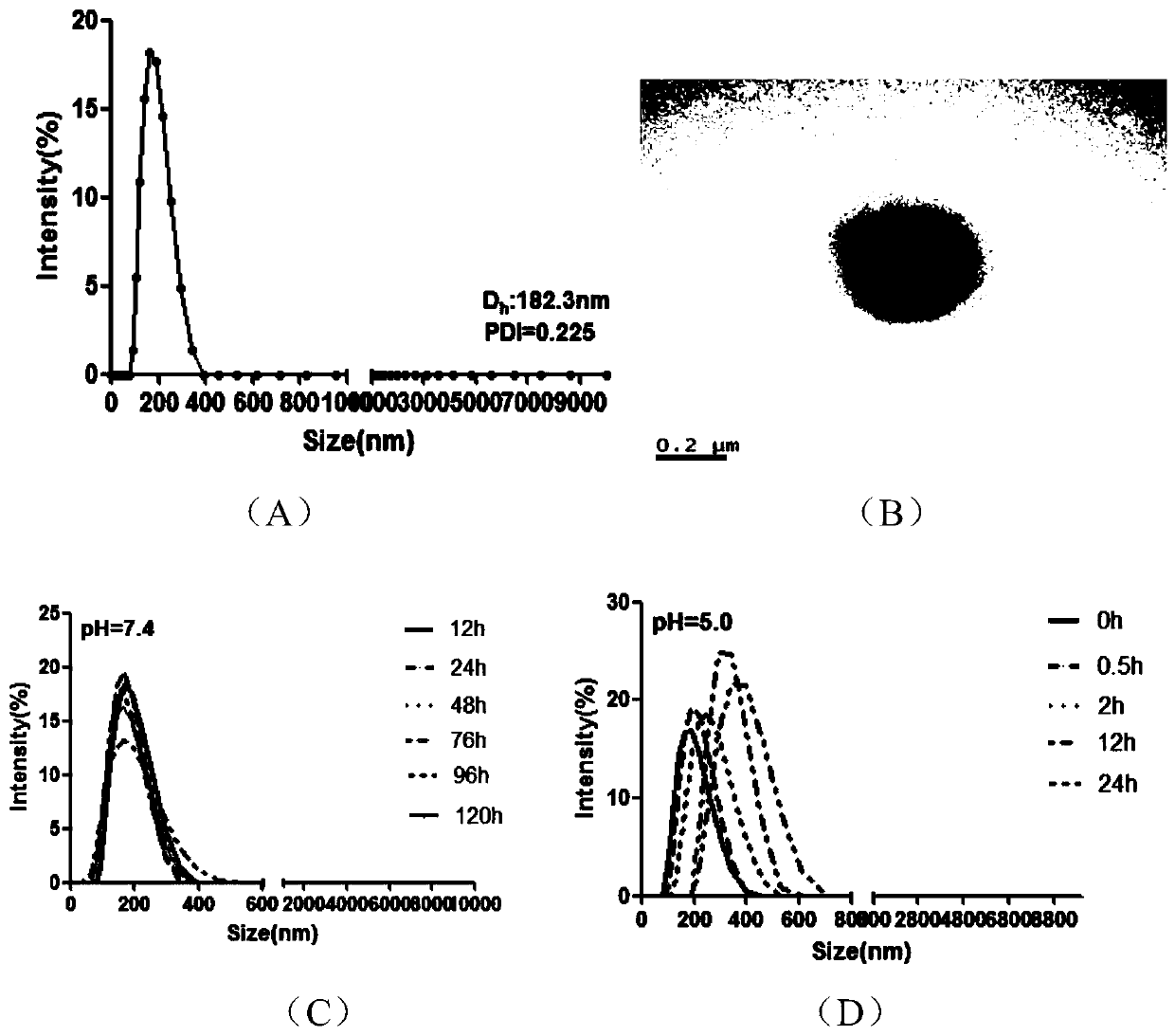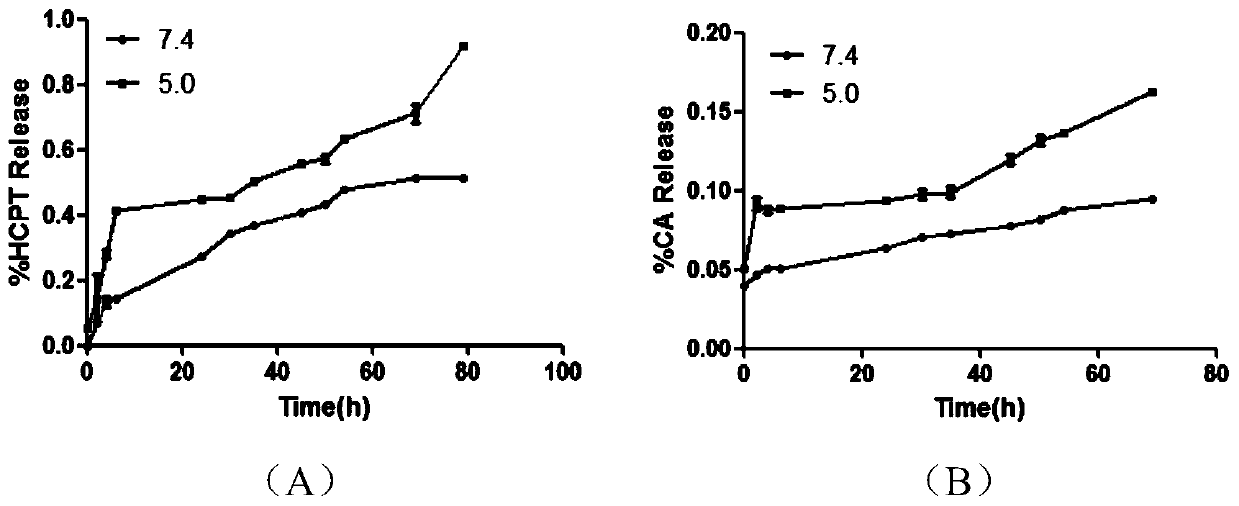Preparation of a drug-loaded cinnamaldehyde-dextran polymer self-assembled nanoparticle and its antitumor application
A kind of technology of glucan and cinnamaldehyde, which is applied in the fields of high molecular polymer and its synthesis and application
- Summary
- Abstract
- Description
- Claims
- Application Information
AI Technical Summary
Problems solved by technology
Method used
Image
Examples
Embodiment 1
[0028] The preparation of embodiment 1 polymer
[0029] (1) Dissolve cinnamaldehyde (5g, 1eq), trimethyl orthoformate (18.07g, 4.5eq) and pyridinium p-toluenesulfonate (1.89g, 0.2eq) in an appropriate amount of methanol, at 60°C , Reaction 3h. with saturated NaHCO 3 Quenched reaction, extracted three times with EA (ethyl acetate), combined organic layers, MgSO 4 Dry and spin dry under reduced pressure to obtain cinnamon acetal (6.45 g, 95%), which is directly carried out to the next reaction.
[0030] (2) The obtained cinnamon acetal (6.4g, corresponding to 2 equivalents of each hydroxyl group of dextran monomer), dextran (0.872g, MW=20,000), pyridinium p-toluenesulfonate (0.202 g, corresponding to each hydroxyl group of dextran monomer 0.05 equivalent), dissolved with DMSO (10ml), added activated Molecular sieve, N 2 Protected, reacted in an anhydrous and oxygen-free environment, heated at 60°C, and reacted for 60h. The molecular sieves were removed by suction filtrati...
Embodiment 2
[0033] (1) Weigh 5 mg of the polymer obtained in Example 1 and dissolve it with 1 ml of DMSO, drop it into PBS under high-speed stirring, and stir for 2 minutes to fully self-assemble and form nanoparticles. Then DLS detects its particle size, the particle size result is as follows figure 2 As shown in A, the size of nanoparticles formed by self-assembly is about 182.3nm, and its PDI value is 0.225, and the comprehensive evaluation is GOOD.
[0034] (2) Take the self-assembled nanoparticle solution, dilute it with water to 0.125mg / ml, then slowly drop it on the copper grid of the transmission electron microscope, dry it in an oven at 25°C, and then observe it under the transmission electron microscope. The result is as follows figure 2 As shown in B, nanoparticles of about 200 nm are formed.
[0035](3) Take 5 mg of cinnamaldehyde-dextran polymer, dissolve it in 1 ml of DMSO, shake for 2 minutes, and shake evenly. The DMSO solution is dropped into the PBS solution which is...
Embodiment 3
[0039] Take 5 mg of cinnamaldehyde-dextran polymer and dissolve it with 0.5 ml DMSO, and weigh 2 mg of HCPT (10-hydroxycamptothecin) and dissolve it with 0.5 ml DMSO. Mix the two evenly, drop them into 20ml of PBS that is stirring at high speed with a rubber dropper, stir for 4 hours, then dialyze in ultrapure water with a 3.5kd dialysis bag, change the water every 4 hours, and dialyze for 24 hours. Liquids are freeze-dried. The amount of drug loaded was judged by the standard curve of camptothecin. It can be detected that the entrapment rate of camptothecin is about 54%, and the entrapment amount is 0.216mg / mg. It can be seen that the nanoparticle has the ability to load drugs.
[0040] Performance Determination of Drugs for Targeted Release:
[0041] Take 3ml of the dialyzed solution (into a 1000KD dialysis bag, dialyze in 50ml of PBS (pH7.4, 5.0) at 37°C with stirring, and take out 0.3 ml (take three in parallel), measure the OD values of cinnamaldehyde and CPT at 295...
PUM
 Login to View More
Login to View More Abstract
Description
Claims
Application Information
 Login to View More
Login to View More - R&D
- Intellectual Property
- Life Sciences
- Materials
- Tech Scout
- Unparalleled Data Quality
- Higher Quality Content
- 60% Fewer Hallucinations
Browse by: Latest US Patents, China's latest patents, Technical Efficacy Thesaurus, Application Domain, Technology Topic, Popular Technical Reports.
© 2025 PatSnap. All rights reserved.Legal|Privacy policy|Modern Slavery Act Transparency Statement|Sitemap|About US| Contact US: help@patsnap.com



